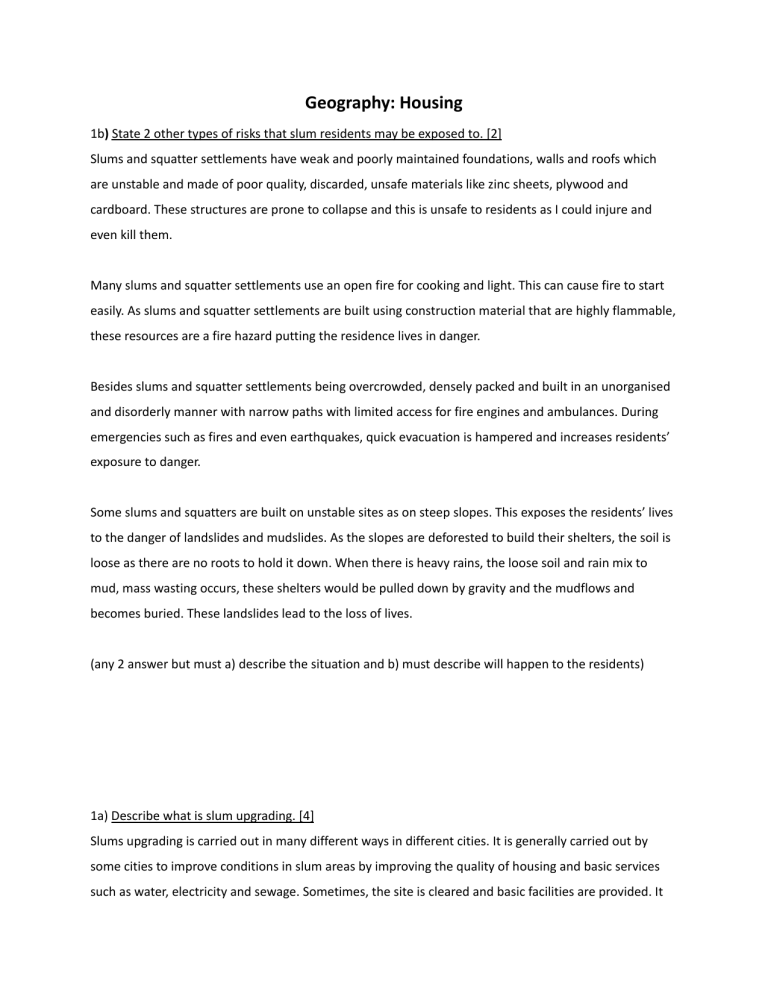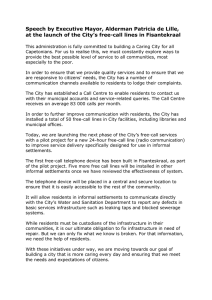
Geography: Housing 1b) State 2 other types of risks that slum residents may be exposed to. [2] Slums and squatter settlements have weak and poorly maintained foundations, walls and roofs which are unstable and made of poor quality, discarded, unsafe materials like zinc sheets, plywood and cardboard. These structures are prone to collapse and this is unsafe to residents as I could injure and even kill them. Many slums and squatter settlements use an open fire for cooking and light. This can cause fire to start easily. As slums and squatter settlements are built using construction material that are highly flammable, these resources are a fire hazard putting the residence lives in danger. Besides slums and squatter settlements being overcrowded, densely packed and built in an unorganised and disorderly manner with narrow paths with limited access for fire engines and ambulances. During emergencies such as fires and even earthquakes, quick evacuation is hampered and increases residents’ exposure to danger. Some slums and squatters are built on unstable sites as on steep slopes. This exposes the residents’ lives to the danger of landslides and mudslides. As the slopes are deforested to build their shelters, the soil is loose as there are no roots to hold it down. When there is heavy rains, the loose soil and rain mix to mud, mass wasting occurs, these shelters would be pulled down by gravity and the mudflows and becomes buried. These landslides lead to the loss of lives. (any 2 answer but must a) describe the situation and b) must describe will happen to the residents) 1a) Describe what is slum upgrading. [4] Slums upgrading is carried out in many different ways in different cities. It is generally carried out by some cities to improve conditions in slum areas by improving the quality of housing and basic services such as water, electricity and sewage. Sometimes, the site is cleared and basic facilities are provided. It requires the residents to move out and relocate temporarily. Financing schemes and assistance are also provided to fund the project. In the self-help scheme, residents are not relocated. Instead the government provided proper building materials for the residents to build their own houses at a pace that is feasible for them. The government will provide basic services like water, electricity and sewage. The government will also provide training in construction skills for the residents. 1b) Describe 2 advantages of the self-help scheme. [2] - Self-help scheme is cost-efficient. The government provides the building materials for the residents to build their homes. This saves on labour cost. For a given government budget, more squatters may be helped. - As the residents are not required to move out of their current homes, there is no eviction and displacement. This is beneficial to both the residents and the government. Residents would not be inconvenienced and the government does not need to look for temporary shelter. - Self-help schemes provide training for residents to learn construction skills. These skills can allow residents to find jobs in the construction industry - Construction skills will also be beneficial to the urban areas in LDCs as they will provide skilled labour to the growing economy - By building their own houses and neighbourhood, residents will feel a sense of belonging and community. 1c) Describe 2 challenges that may hinder the success of the self-help schemes. [2] - As residents work at their own pace, the progress is slow and it takes a long time for the project to complete - The skills of the residents may not be good even with training. His buildings may not be well built. Cracks and other signs of wear and tear will eventually occur. - Without funds to restore wear and tear over the years, the scheme is not sustainable as there is no renewal - Funding for construction materials and facilities are limited, this scheme is difficult to sustain and is not able to keep up with the continuously high demand of housing in the cities Revision Notes: What is the difference between slum and squatter settlement? Squatter Settlements Slums Similarity Are substandard housing Are substandard housing Similarity In urban areas In urban areas Similarity A lot of pollution eg. death ,water pollution, air pollution A lot of pollution eg. death ,water pollution, air pollution SImilarity Away from the rich Away from the rich Difference Improper, makeshift Dilapidated, neglected Difference Illegal for housing purposes Legal for housing purposes Difference No basic facilities Have basic facilities but are neglected and run down The urban area is used for a lot of things, eg. factory, industries - Not enough land for cheap housing - Limited land cause of competitive use - Some land is unsuitable (eg slopes, valleys) - Demand is higher than supply, lead to an increase in price Solution for the housing shortage - Self-help scheme - Inclusiveness → price is the lowest → subsistence give to Singaporean → have different type of flats → cater to different household and income → Page 97 para 2 → range of people with different races → so that there is no racial enclave → 3G facilities and amenities → serve as a platform for others to make friends → form a strong and bonded community → have a sense of belonging Push and pull factors Push - (famine, natural disasters etc) Pull - (faster lifestyle, freedom, better entertainment and education and job opportunity and income, more sophisticated)


